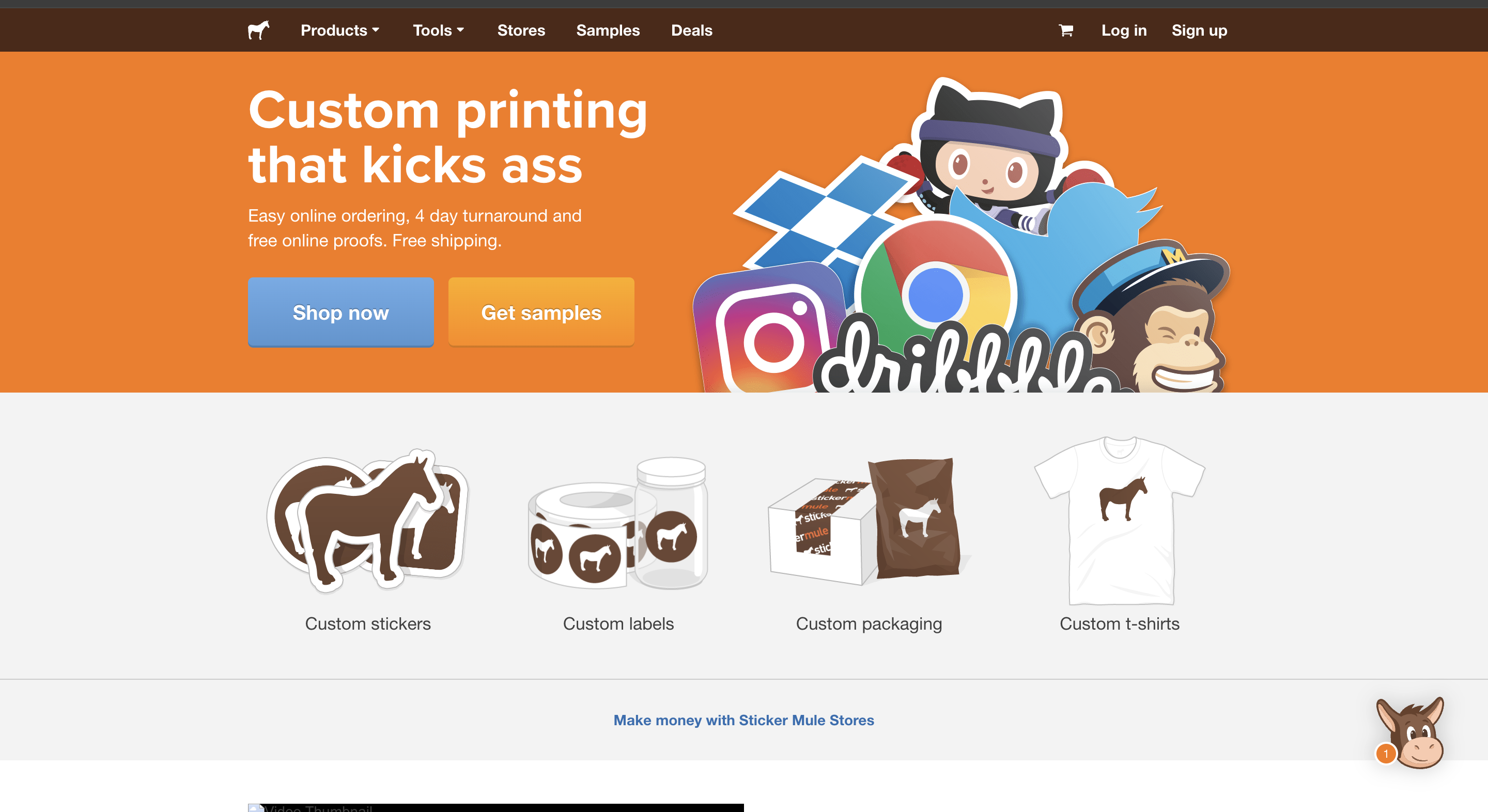Ist Ihre Preisseite der unbesungene Held Ihrer Website, oder ist sie der Ort, an dem die Träume von Conversions sterben?
Ihre Preisseite ist nicht nur ein Menü mit Zahlen. Hier ist der Grund, warum sie wichtig ist:
- Hier wird aus dem Zögern ein Handeln
- Es ist Ihre letzte Chance, den Wert Ihres Angebots vor der großen Entscheidung zu präsentieren.
- Sie kann die Customer Journey Ihres Kunden bestimmen oder beenden.
Tipp: Prüfen Sie noch heute Ihre Preisseite. Ist das Preismodell klar, überzeugend und Conversion-freundlich?

Beispiel für eine Preisseite: Die Prüfstrategie
Stickermule testet und bietet ein Muster zu einem niedrigen Preis an, um die Conversions zu maximieren. Es gibt auch andere Standard-Preispläne, aber die Seite konzentriert sich darauf, das Produkt in die Hände des Käufers zu bringen.

Wenn der Preis des Musters so niedrig ist, dass es nur wegen des Preises gekauft wird, könnte das ein Problem darstellen, denn es bedeutet, dass der Shopper nicht verdaut hat, was Sie zu regulären Preisen verkaufen.
Aber es ist nicht so schlimm, wie es aussieht. Auf diese Weise bringt das Unternehmen den Kunden dazu, das Produkt auszuprobieren, und diejenigen, die es mögen, werden langfristig immer für einen höheren Wert sorgen.

Alles in allem:
- Lassen Sie Ihre CTA- oder Call-to-Action-Schaltflächen den Besuchern die Möglichkeit, eine Probe zu kaufen oder einige der Funktionen Ihres Produkts kostenlos oder zu einem niedrigen Preis auszuprobieren.
- Stellen Sie sicher, dass sie verstehen, worum es Ihnen geht, bevor sie mit ihrer bevorzugten Preisoption zum Checkout gehen.
- Helfen Sie Ihren Besuchern, sich von der Qualität Ihrer Funktionen oder Produkte zu überzeugen, ohne dass sie dafür viel Zeit oder Geld ausgeben müssen.
Dieses Beispiel zeigt, wie selbst gut gestaltete Seiten von einer kontinuierlichen Optimierung und Klarheit profitieren.
Patrick Campbell, CEO von ProfitWell, stellt fest: "Ihre Preisstrategie ist einer der wichtigsten Hebel für Wachstum, wird aber oft übersehen. Hier erörtert er, wie Sie Preisänderungen mit Wertmetriken in Einklang bringen können.
Hier erfahren Sie, wie Sie Ihr Experimentieren optimieren können:
Hohe Wirkung, geringer Aufwand
- Variationen vonCTA-Schaltflächen
- Positionierung von Plänen
- Hervorhebung von Merkmalen
- Strategien zur Preisverankerung
Hohe Wirkung, hoher Aufwand
- Optimierung des Zahlungsflusses
- Überarbeitung der Tarifstruktur
- Optionen für Funktionsbündelung
- Verbesserungen der Onboarding-Integration
Sehen Sie als Nächstes, wie Sie Ihre Preisseite bestmöglich optimieren können.
6 Profi-Tipps zur Optimierung Ihrer Preisseite
-
Der ethische Drahtseilakt: Preis-Tests
Als ersten Schritt könnten wir Ihnen A/B-Tests für Ihre Preisseite empfehlen, aber ist das ethisch vertretbar?
Schauen wir uns das genauer an:
- Das Gute: Es hilft Ihnen zu verstehen, was potenzielle Kunden schätzen.
- Das Schlechte: Es kann manipulativ wirken, wenn es nicht transparent gemacht wird.
- Das Hässliche: Eine inkonsistente Preisgestaltung auf einer Landing Page kann das Vertrauen beschädigen.
Alles in allem können Preistests ethisch vertretbar sein, wenn sie transparent sind und die Daten genutzt werden, um einen besseren Wert zu bieten, anstatt nur den Gewinn zu maximieren.
Zeigen Sie Ihren Kunden stattdessen, was sie ohne Ihr Produkt verpassen würden. Lassen Sie sie das FOMO durch ein interaktives Erlebnis spüren.
- Zeigen Sie die Probleme auf, mit denen sie ohne Ihre Lösung konfrontiert werden
- Verwenden Sie Vergleichstabellen, um zu zeigen, was sie vermissen
- Erzählen Sie Geschichten und Zeugnisse von erfolgreichen Kunden, die den Sprung geschafft haben
Beispiel: Als Basecamp das Design seiner Preisseite analysierte, stellte es fest, dass die prominentere Darstellung von Jahresplänen zu einer 14%igen Steigerung der Conversions zu kostenpflichtigen Plänen führte.
-
Machen Sie Ihr Angebot zum eigentlichen MVP
Der Wert Ihres Produkts ist wichtiger als sein Preis.
Laut dem SaaS Pricing Strategy Report 2023 von OpenView ist die Preisgestaltung durch Mitbewerber (37,5 %) eine häufig genannte Preisstrategie, gefolgt von wertorientierter Preisgestaltung (32,5 %) und Kostenaufschlag (29,5 %).
Während sich viele Unternehmen immer noch auf die Positionierung im Wettbewerb konzentrieren, geht der Trend immer mehr zur wertorientierten Preisgestaltung.
Was Sie Ihren Kunden anbieten, ist viel wichtiger als der Preis, den Sie dafür verlangen. Ein großartiges Produkt oder eine großartige Dienstleistung kann seinen Preis rechtfertigen, aber ein niedriger Preis kann ein minderwertiges Angebot nicht wettmachen.
Hier ist der Grund:
- Ein starkes Angebot kann einen höheren Preis rechtfertigen
- Es hebt Sie von der Konkurrenz ab
- Es schafft einen wahrgenommenen Wert jenseits des Preisschildes
Definieren Sie als Unternehmen das Problem, das Sie angehen, bevor Sie überhaupt über den Preis nachdenken.
Bieten Sie außerdem personalisierte Erlebnisse an. Unternehmen erforschen auch die KI-gesteuerte personalisierte Preisgestaltung. Sie passt die Angebote an das Nutzerverhalten und die individuellen Vorlieben an.
-
Kürzen Sie nicht die Preise
Die Preise zu senken, nur damit potenzielle Kunden auf die Schaltfläche "Jetzt kaufen" klicken, ist, als würden Sie sich selbst die Haare schneiden.
Preisnachlässe fühlen sich zunächst gut an, hinterlassen aber ein Gefühl des Bedauerns und eine entwertete Marke. Sie:
- Erziehen die Kunden dazu, auf den Verkauf zu warten
- können Verzweiflung oder schlechte Qualität signalisieren
- schmälern Ihre Gewinne schneller, als Sie "Schnäppchen" sagen können
Anstatt die Preise zu senken, schaffen Sie Mehrwertangebote und eine transparente Preisgestaltung.
Versuchen Sie, exklusive Inhalte oder benutzerfreundliche Funktionen anzubieten. Bieten Sie einen hervorragenden Kundendienst an. Bieten Sie ergänzende Produkte oder Dienstleistungen an.
Diese klare Preisgestaltung hält Ihre Preise stabil und gibt Ihren Kunden mehr Gründe, ihre Kreditkarte zu zücken und sich für Sie zu entscheiden.
Beispiel: Dropbox ermöglicht es seinen Nutzern, einen Tarif zu wählen, der ihren Anforderungen am besten entspricht, und wenn ihre Bedürfnisse wachsen, können sie nahtlos auf eine höhere Preisstufe aufsteigen.

Quelle: Dropbox
-
Die Pfennigfuchser im Visier
Haben Sie preissensible Kunden? Versuchen Sie diese Strategien:
- Gestaffelte Preise: Bieten Sie verschiedene Servicelevels an
- Bündelangebote: Kombinieren Sie Produkte für einen zusätzlichen Nutzen
- Loyalitätsprogramme: Belohnen Sie Stammkunden
Beispiel: Im E-Commerce-Sektor hat sich die Preisstrategie "Abonnieren & Sparen" von Amazon als besonders effektiv erwiesen, um die Kundenbindung zu erhöhen und den durchschnittlichen Bestellwert zu steigern.
-
Kostenloses Angebot: Das Tor zu kostenpflichtigen Funktionen
SaaS-Unternehmen haben oft teure Produkte. Um dieses Problem zu lösen, geben Sie Ihren Kunden einen kostenlosen Vorgeschmack auf Ihre Produktfunktionen, und sie werden wiederkommen, um mehr zu bestellen. Hier sehen Sie, warum das funktioniert:
- Niedrige Einstiegshürde für neue Benutzer
- Zeigt den Wert der Premium-Funktionen
- Schafft ein Gefühl der Investition in Ihr Produkt
Achten Sie jedoch darauf, dass Ihr kostenloses Angebot wertvoll genug ist, um Nutzer zu fesseln, aber auch begrenzt genug, um Upgrades zu fördern.
Beispiel: Optimizely bietet Ihnen auf seiner SaaS-Preisseite die Möglichkeit, Feature Flags KOSTENLOS auszuprobieren.

Quelle: Optimizely -
Der Vergleichseffekt: Ethische Tricks
Nutzen Sie die Macht des Vergleichs, um Nutzer zu einem bevorzugten Preispaket zu führen. So geht's:
- Führen Sie eine etwas weniger attraktive Option in der Nähe Ihres Zielplans ein
- Stellen Sie sicher, dass Ihre bevorzugte Option und die Add-ons visuell hervorstechen.
- Verwenden Sie klare, eindeutige Wertangebote für jede Stufe
Beispiel: Auf der Casper Matratzen-Seite finden Sie eine Vergleichstabelle, in der die Matratze, die Sie sich ansehen, mit Caspers höherwertigem Modell verglichen wird.

Quelle: Casper Auf diese Weise kaufen viele Besucher am Ende das Basismodell, weil es ihnen im Vergleich so viel günstiger erscheint, was zu besseren Conversion Rates führt.
Kennen Sie Ihre Metriken
Um die Leistung Ihrer Preisseite effektiv zu überwachen, sollten Sie die folgenden Schlüsselkennzahlen verfolgen:
Primäre Metriken
- Conversion Rate nach Preisstufe
- Durchschnittliche Zeit bis zur Entscheidung
- Absprungrate und Absprungpunkte
- Conversion Rate für wiederkehrende Besucher
- Vergleich zwischen mobiler und Desktop-Leistung
Sekundäre Metriken
- Interaktionsraten beim Vergleich von Funktionen
- Häufigkeit des Zugriffs auf die Hilfe-Dokumentation
- Engagement im Chat-Support
- Messungen der Auswirkungen von A/B-Tests
Die Moral von der Geschicht...
Machen Sie es nicht (nur) schön!
Seit dem Aufschwung des E-Commerce und der SaaS-Unternehmen sind die Preisseiten das digitale Schaufenster geworden.
Aber Ihre ach so offensichtlichen Behauptungen "Wir sind jeden Cent wert" und "Unsere Funktionen sind erstaunlich" reichen nicht immer aus, um Kunden zu überzeugen.
Bei den anpassbaren Optionen auf Ihrer Preisseite geht es also nicht nur darum, sie hübsch zu gestalten. Es geht um einfache Preise, ein gutes Onboarding und:
- Ihr Wertversprechen auf den Punkt bringen
- Mehrwert durch Anwendungsfälle schaffen, anstatt die Preise zu senken
- Testen, Wiederholen und Optimieren Ihrer Preistabelle
- Transparenz in Bezug auf Ihre Preise und die Liste der Funktionen
- Kunden dabei helfen, die beste Wahl zu treffen
- Vermeiden Sie manipulative Taktiken und bieten Sie Social Proof
- Regelmäßige Analyse des Erlebnisses der Nutzer
Die perfekte Preisseite erfordert Zeit, Liebe zum Detail und regelmäßiges Optimieren, um sie genau richtig zu machen.
![]()
- Zuletzt geändert: 06.02.2025 17:44:15
